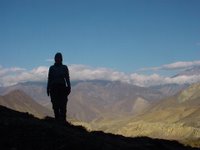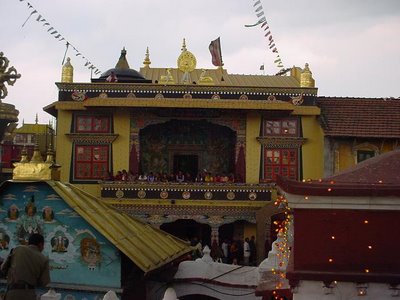"I realized how much of a schedule-rigid American I was when I was over there," Kelly wrote to me before I got to Nepal. "They operate in a totally different way and do a lot less scheduling in advance."
Kelly stayed with the Muktinath nuns two years ago, and throughout my preparations for this trip, her advice and support have been invaluable to me. Today, I got to experience for myself the truth of her observation about scheduling.
A knock on my door just before 6 am.
"Lama, whole family go stupa, you also go?"
I translated this to mean, "Lama’s immediate family is going on their daily morning stroll around Bodhnath Stupa. Would you care to join them?"
It actually means, "Lama’s extended family is going on their annual pilgrimage to three stupas, one of which is a two-hour drive over dirt roads up an unbelievably high mountain. Would you care to join them?"
As we get into a truck, Lama explains that today is an auspicious day in the Tibetan calendar. The three-stupa round, apparently, carries a lot of merit. I feel privileged to accompany them, although still not sure what this entails. "Last year, nuns also come," he recalls. "Nuns like family. Lama’s whole family. Now, also you." My initial disorientation on arriving in Nepal has continually been eased by the generosity and friendliness of Lama and his family. Cheerfulness and good humor shines from their expressive faces and hands.
I ask Lama who all the people in the back of the truck are. He repeats, "Lama’s whole family."
"But who are they, exactly? Your nieces, cousins…?" I feel rude for insisting. I do get it figured out that the man in the back seat with me is Lama’s brother, and the man driving is no relative, but the hired driver for the truck, which belongs to a school which with Lama is somehow involved. I think the woman is Chime’s sister, the four girls are her daughters. Lama’s wife and children are also in the back. Everyone laughing, talking.
Swayumbhu
We go first to Swayumbhu, which is also known as Monkey Temple because of the numerous monkeys clinging to the walls and darting across the ground. One of the little girls scrunches up her face and huddles close to Apple whenever the monkeys are near.
“Do they bite?” I ask Apple.
“Sometimes,” she says, smiling.
NamobuddhaNext on the list is Namobuddha. The little girl who was afraid of monkeys becomes carsick and is vomiting over the side when we stop for tea and biscuits midmorning. I ask Lama if I should switch places with her and he said, “No, she doesn’t like to sit inside. In the back, family talking talking!”
We go on, always continuing up, impossibly high above roads and houses and farms. I think, “This is how high airplanes go.” A web of colorful Tibetan prayer flags appears in the distance. Now we’re on a road, which, if stood on its head, would make an excellent climbing wall. The jostling is so strong that it aches my breasts, and I cross arms over my chest discreetly. There are times when we go around a bend and, from my perspective, the road disappears, so we’re suspended over the void. The passengers in the back squeals and shouts. This is the best family outing I've ever been on. Before I left Colorado, Nick and I had planned to go to a Six Flags amusement park and ended up having to cancel, but this roadtrip is as thrilling as any roller coaster.
I look back. Two of the little girls are standing up and dancing in the truck.
We come around a curve just in time to see someone vomit out the side of a large bus, coming full tilt towards us. Our truck and the bus brake to avoid colliding. The bus is packed full, with people on the roof and spilling out the sides. There’s only room for one vehicle on this road, so our driver backs up until he can pull over to the side and allow the bus to pass.
When we get there, we eat a quick picnic lunch and Lama greets the head of the monastery. We hike up to the shrine where Buddha, in one of his incarnations, offered his body to a mother tiger and her cubs. (Later, Lama tells me the story in his own words, so evocatively and descriptively that I can't do justice to his version by repeating it, but lots of version can be found by googling.)
The women and children take lots of pictures while Lama and his brother do puja in front of the shrine. Prayers, meditation and ordinary life seem to be intimately bound up here—Lama’s wife interrupts the men to ask where her son is, and the children walk behind them to talk and point at the view. Nobody ever gets angry and says, “Don’t bother me, I'm being spiritual!” Lama’s son hates having his picture taken and his mother and sisters get a great rise out of sneaking up to him and snapping his picture.
Plenty of other pilgrims here today, although it’s nowhere near as crowded as Swayambhu. I'm the only Westerner, but there are Indian and Nepali people as well as Tibetans. A pilgrimage, social event and family outing all in one.
We hike down to the stupa itself. Lama tells me that last time they were here, one of the nuns fell on the path. I'm barely managing to keep my balance in Tevas, but many of the women are wearing high heels. Lama’s wife is one of them. Her strap breaks. She laughs and says to me, “My shoe—completely gone!” She walks barefoot down the slippery slope.
We stay at the stupa for an hour or so. Lama and his brother do more puja. They hold out a bundle of prayer flags to me. “Bless it! Bless it!” the childen say. “Touch with head.” I touch my head to the bundle. “Later, burn,” they explain.
The small girl who was afraid of monkeys takes pity on my ignorance and leads me inside a shrine. “Come, come.” She shows me how to prostrate to the butter candle encircled Buddha. When we’re done, she nods with satisfaction.
A man climbs onto the stupa, whitewashes it, decorates it with gold paint. Lama tells me that he has sponsored not only this stupa but the other two stupas. I don’t know if the amount he names, in thousands, is in rupees or dollars. “It’s very lucky,” he says with a big smile. “This day, and visit three stupas, and Lama sponsor. Lucky. Good omen.”
Later:
Back in the truck and down the mountain again. Before returning to Bodhnath, we drive into a small village and come to a temple. It looks much older than the other places we’ve seen, but I don’t know if that’s just because it hasn’t been renovated lately. There’s a scaffold around the main shrine and it looks like some work is being done. We take off our shoes and go inside. It’s dark and moist. A man sits near the shrine. We give him rupee bills and he gives us red paint to daub our foreheads with, and a flower. This seems like a more local event—there are only a few other people here, and no Westerners except me. Yet nobody looks at me strangely or questions my presence.
Back to Dragon Guest House to rest for an hour, then join the pilgrims at Bodhnath Stupa. I follow Lama and his brother on a stroll around the upper level. I can hardly take in everything I have seen and heard today. Even after only a few days, Bodhnath Stupa feels comfortingly familiar to me. The sun is setting. A couple of Korean tourists stop me to ask me to take a picture of them. “You look so peace, we did not like to disturb,” they say apologetically.
As I walk to catch up with Lama, a tall white man with a camera stops me. He’s also a guest at Dragon. “Excuse me, who was that man you were walking with?”
“That’s Wangyal Lama,” I tell him.
“He is rinpoche—yes?” His English is excellent but heavily accented—German, Swiss, I'm not sure.
“Yes, rinpoche.”
“His face is so strong! It’s not often that you see such a beautiful man. I wanted to ask him if I could take a photo, but he is so strong-looking, I did not like to.”
Having just asked Lama to pose for me a few minutes ago, and then casually asked him to photograph me, I suddenly feel shy. Had I imposed—or, worse, been unbelievably rude?
“You are not interested in Buddhism?” the man continues.
“Yes, I am very interested.”
“The reason I asked was that if you were a disciple of a rinpoche, usually you would be more afraid. You would not be so comfortable in his presence.”
I give him a strange look and he amends, “Well, maybe not.”
I'm not sure why I wouldn’t be comfortable in the presence of someone so kind. I'm more often than not afraid of people, or at least hugely anxious, but I tend to assume that has more to do with my own insecurities than who the people are.
Now that I think of it, I'm less frightened than usual around great and wise teachers, precisely because they’re so relaxed themselves.
I don’t have the words at the moment to express all this. The man asks me a few more questions about Lama, and then stops to take more photographs. (“I'm glad I brought this zoom—I can get very close to people without them ever knowing.”)
I catch up with Lama and tell him what the man said. “Ah, many people tell me I look strong,” he says. “I know this. But inside, I am not strong. Inside, soft.”
We sit for while. Lama and his brother pray and chant. He waves goodbye to a group of teenage monks as they descend the stupa. A few raindrops fall. We spin the prayer wheels and start home.

 dusted with green
dusted with green



























